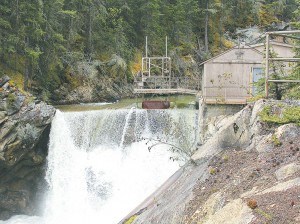 Energy that Jasper uses is generated by two power plants in the park, the Palisades Plant and Astoria Dam. Both are approximately 50 years old.
Energy that Jasper uses is generated by two power plants in the park, the Palisades Plant and Astoria Dam. Both are approximately 50 years old.
“A natural gas fire generating station like [the Palisades Plant] is considered to be one of the most environmentally friendly power sources out there, if you’re going to use fuels,” said ATCO district manager Rod Carruthers.
The Palisades Plant used to have diesel-powered generators and now there are only a few generators left that burn diesel as a backup alternative.
Since energy produced by the Astoria Dam requires no fuel or emissions, this power is first priority for use. The two generators powered by the Astoria Dam typically produce 1.4 megawatts of power. This figure accounts for the river’s maximum water flow and is reduced during winter months when flow lessens or completely stops.
Aside from some efficiency upgrades a few years ago, including securing the oil containment in case a transformer blows open, Carruthers said it’s difficult to make a case for upgrading the dam and making it larger.
“More capacity could be gained by reconfiguring and rebuilding the dam and bringing everything up to date,” said Carruthers. “But the backside is that there is no more water and we wouldn’t want to impede any further on the water flow, from an environmental point of view.”
Currently, 20 per cent of water flow from the Astoria River goes through the dam, while the remaining 80 per cent flows around and over it.
The smallest upgrade to get any significant benefit would be to change the generator and turbine, he adds. This isn’t a straightforward job because the new generators wouldn’t neatly fit into the same spaces.
“There would also be a temporary disturbance in water flow.”
Alberta is the only province with private power systems, so with producers, transmitters and retailers, the industry can be complicated, admitted Carruthers.
Producers generate power, transmitters (like ATCO Electric) move it, and retailers sell it.
Retailers buy electricity from generators and pay transmitters to move it for them.
Jasper is unique when it comes to power price rates, said Carruthers. Much of the province is interconnected on a power grid and joined by power lines, but Jasper isn’t.
ATCO Electric recently renewed its 10-year franchise with Parks Canada. This means that the company will continue to transmit power to Jasper.
Even though Jasper is not physically connected to the provincial power grid, the town is still given the same rates as if it were. Rates could be more expensive with Jasper on its own power system.
There are numerous power retailers in Alberta, so consumers have a choice. It’s even possible to live in Jasper and still purchase power from a retailer that sells 100 per cent green energy, said Jurgen Deagle, an environmental management specialist for Jasper National Park.
“You’re not buying the energy from the Palisades power plant, you’re buying energy from the Alberta system. It physically happens to be coming from [the Palisades] power plant, but power units are virtually traded back and forth,” he explains.
The customer receives power from Jasper, but is financially supporting a retailer that purchases green energy.
A list of power retailers is available at www.ucahelps.alberta.ca.
Power consumption in Jasper has decreased, especially since the early 1990s when the town peaked at 11 megawatts. This was before the Trans Mountain pipeline moved its major pump station to Hinton.
On a federal level, Parks Canada was given the mandate to reduce its greenhouse gas emissions below the 2005 level at a rate of one per cent per year, said Deagle.
For the year 2005/06, Jasper’s carbon dioxide emissions were 4.5 tonnes and the next year was 4.2. It has decreased every year since then, he said.
This stems from many green initiatives, including replacing the generator at Maligne Lake with solar panels, video-conferencing to reduce travel, and establishing guidelines for purchasing Parks Canada fleet vehicles.
The best potential for less power generation is if people reduce their consumption, said Carruthers.
“It’s all education of these little energy suckers throughout the house that you’re not even paying attention to,” said Janet Cooper, environmental stewardship coordinator.
The next community conversation is on July 3 at 7 p.m. in the Seniors Lounge, located in the Activity Centre. Green building will be the topic of discussion. Homeowners who have built or retrofitted their homes using sustainable building practices will be on hand to share their experiences.



